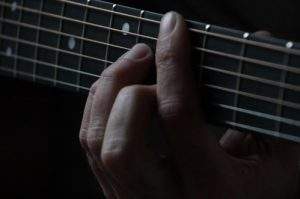
Playing barre chords on the guitar can prove to be quite a challenge for beginners. It demands a combination of finger strength and dexterity to effectively press down all the stringswith just one finger. The pursuit of achieving a clear and clean sound might seem nearly impossible in the initial stages of practice.
However, with dedication and the right techniques, the journey to mastering the barre chord opens up a world of musical possibilities and rewards for guitar players.
What Are Barre Chords?
Barre chords, also known as bar chords, are a fundamental technique in classical guitar playing. They involve using one finger, usually the index finger, to press down multiple strings.
By creating a "bar" with the finger, the guitarist can effectively replace the need for individual finger placements. And this allows for the simultaneous playing of multiple notes.
The Importance of Barre Chords in Classical Guitar
Barre chords are essential for classical guitarists as they provide flexibility and versatility in playing various chord progressions and melodies. They allow for the creation of complexharmonies and the exploration of different tonalities across the fretboard.
Techniques for Playing Barre Chords
1. Lower Your Thumb and Find the Sweet Spot
Beginners often commit the mistake of placing their thumbs too high on the back of the neck.
Some may even wrap them around the neck. Doing so will make it hard to apply enough pressure to successfully hold down all the guitar strings.
What you should do is lower your thumb and place it about halfway down your guitar’s neck. This allows your wrist to align with the floor to play the chords much easier. Consider experimenting where your thumb and index finger are slightly offset or aligned to find the “sweet spot.”
2. Use the Edge of Your Index Finger
Instead of your index finger’s flat face, use its edge to apply pressure. Your finger’s edge is quite harder and bonier, which requires lesser force to hold down all the strings. When using the edge of your finger, place the barre on the fretboard while pushing away from the headstock. You may need to adjust your elbow position to master this technique.
3. Keep Your Elbow Tucked In
Keeping your elbow closer to your body will help you roll your index finger onto its side effectively. That way, you can perform the second technique better. Additionally, keeping your arm hanging naturally next to your body allows for a more efficient and comfortable playing position.
4. Position Your Index Finger Close to the Fret
Placing your index finger close to the fret, rather than directly on it, requires less pressure to produce a clean sound. This technique involves rolling your finger onto its edge right next to the fret. It places the edge of your index finger in the perfect position to hold down the strings effectively.
5. Keep Your Index Finger Straight
Maintaining a straight index finger is crucial for producing clear barre chords. If your finger is slightly arched, some strings may be muted while others ring out. Keep your finger flat and straight to ensure even pressure across all the strings.
6. Adjust the Height of Your Index Finger
The clarity of the barre chords produced may also depend on the height of your index finger. If the string aligns with the crease in your index finger, it will mute the string. So, experiment with moving your index finger slightly down and up to figure out the right position where all the strings ring out clearly.
Pay close attention as to how much of your finger is sticking out above the fretboard once you achieved your desired sound.
7. Maintain a Low Wrist Position
Another mistake of beginners when playing barre chords is they bend their wrist too much against the neck. Some may even press the palm of their hands, which is wrong. Both these positions will hinder your ability to play chords and even lead to discomfort.
What you should do is keep your wrist low. You have to maintain a slight arc in your hand. Doing this will allow for better mobility. And most importantly, this minimized the strain on your wrist and hand.
8. Utilize Arm Strength
Using your arm strength to hold down the strings will help alleviate the pressure on your index finger and thumb. As you play the barre chord, pull backward using your left arm. Then, “hug” the guitar’s body between your chest and right arm. This playing technique allows your arm to apply pressure on the strings instead of just relying on your fingers.
Like any other technique, experiment until you find the right balance of your finger and arm strength.
Quick Switching Between Barre Chords
Once you’ve mastered the basic technique for playing barre chords, consider practicing how you can smoothly switch between barre chords.
Here are some tips:
● Release pressure off the strings during chord changes to avoid unwanted noise.
● Keep your fingers in the shape of the previous chord as you slide up or down the neck to the next chord.
● Practice transitioning between barre chords with a metronome to improve your timing and accuracy.
Remember, practice is key when mastering barre chords. Be patient with yourself and focus on gradual improvement rather than expecting immediate perfection.
Easy Alternatives for Beginners
There are some easy alternatives that can be used as stepping stones for beginners. These alternatives provide a simplified version of the chords and can help build finger strength and familiarity with chord shapes.
Here are a few examples:
F Major Alternative: Instead of playing the full F major barre chord, you can use an easier alternative, like the open F major chord or the F major shape without the barre.
F Minor Alternative: Similarly, you can use a simplified version of the F minor chord without the barre to make it more accessible for beginners.
B Minor Alternative: For the B minor chord, you can use the B minor 7 shape instead. It requires less finger strength and dexterity.
Memorizing Root Notes
Memorizing the root notes on the 5th and 6th strings will allow you to play barre chords in any key and navigate the fretboard with ease.
Here’s a simple exercise to help you memorize the root notes:
● Ascend up the 6th string and play only the natural notes (no sharps or flats). Say each note out loud as you play it.
● Descend down the 6th string, playing only the natural notes and vocalizing the name of each note.
● Repeat the same exercise on the 5th string, ascending and descending, while vocalizing the natural notes.
By practicing this exercise regularly, you’ll develop a strong foundation of fretboard knowledge and be able to navigate the neck confidently.
FAQs
Why Barre Chords Are Difficult
There are several reasons why it may be challenging to master barre chords.
● The technique requires significant finger strength and dexterity to press down multiple
strings simultaneously.
● The pressure needed to achieve a clean sound can cause discomfort and fatigue in the
hand and fingers.
● The size and width of the guitar neck, as well as the string tension, can vary between
different guitars, making it more difficult to execute and practice barre chords
consistently.
Do Barre Chords Get Easier?
With consistent practice and proper technique, barre chords do become easier over time. As your finger strength and dexterity improve, you will find it easier to apply the necessary pressure and achieve clear notes.
How Can I Deal with Hand Pain and Discomfort?
Hand pain and discomfort are common issues when learning and practicing barre chords. It is crucial to listen to your body and avoid pushing through excessive pain.
To minimize discomfort, ensure that you are using proper finger placement, avoiding excessive pressure, and taking regular breaks during practice sessions.
Conclusion
Allot enough time, patience, and practice to learn barre chords on your classical guitar. Follow the techniques and exercises outlined in this guide, and you can overcome the initial challenges and unlock the full potential of barre chords.
So grab your guitar, embrace the challenge, and let the magic of barre chords transform your
playing. Happy strumming!

